Transcripción del Video:
A continuación nuestra agenda. Vamos a hacer una rápida descripción general de las impresoras “directo a prenda” (DTG) y las vamos a comparar con las impresoras de sublimación. Luego, revisaremos las diferencias y veremos algunos ejemplos. Finalmente, volveremos a la presentación de PowerPoint y revisaremos costos de puesta en marcha y otros requisitos para su negocio. Empecemos.
Descripción General de Impresoras “directo a prenda” (DTG)
Las impresoras DTG, o “directo a prenda” (DTG) usan tintas pigmentadas a base de agua. Si usted está acostumbrado a imprimir con tintas eco-solventes, o incluso tintas UV, sobre sustratos y los colores resaltan inmediatamente, usted los verá con una impresora DTG. Es lo que le será más familiar. Cuando usted carga su camiseta u otra tela para imprimir, los colores resaltarán. Y si usted está acostumbrado a imprimir, digamos, sobre sustratos transparentes con tintas eco-solventes y tinta blanca, colocando primero una capa de tinta blanca y luego los demás colores encima, pues esto es muy similar a DTG. Así que es casi más cómodo para algunos empezar con una impresora DTG ya que les es muy familiar: se obtiene un resalte instantáneo y buen aspecto en sus productos. Es un proceso muy similar a imprimir con tintas eco-solventes.
Pues empecemos: usted se percatará de que la impresora DTG es mucho más pequeña que una impresora de inyección de tinta. Se ve como una pequeña impresora de inyección de tinta que se puede poner sobre un escritorio. Por tanto, tiene un tamaño más pequeño. Para aquellos que busquen expandirse y no tienen mucho espacio, esta impresora es bastante conveniente. Usted carga sus telas sobre una placa estándar de tamaño modificable según el tamaño de sus camisetas, desde para niños hasta extra-grandes. Estas son diferentes placas sobre las cuales colocar las telas; es decir, cargar los sustratos. También hay placas para mangas y demás productos especializados sobre los cuales imprimir directamente. Las tintas pigmentadas responden mejor en algodón que en sintéticos y poliéster, pero la tecnología de pigmentación ha mejorado. Muchos fabricantes DTG afirman que pueden imprimir sobre mezclas de algodón 50/50, incluso sobre poliéster y sintéticos. Sin importar el tipo de tela, usted necesitará pre-tratamiento, el cual es muy importante: lo tiene que hacer de antemano. Cuando usted va a una feria comercial, ve a los expositores imprimir, pero no ve nada de lo que ocurre tras bambalinas. Permítame mostrarles qué ocurre para que pueda hacerse una idea más precisa del mundo al que va a entrar.
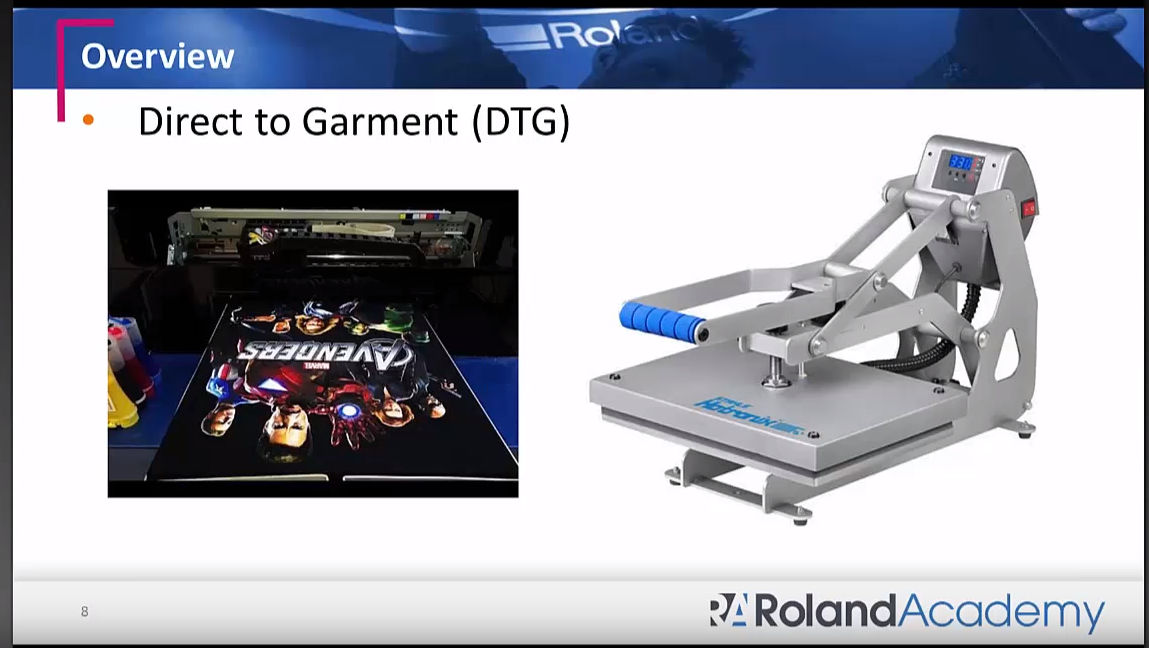
Pre-tratamiento
Usted debe empezar con el pre-tratamiento, y hay una forma simple de hacerlo. Primero, prense la prenda durante 10 a 15 segundos. Esto aplanará cualquier fibra suelta que pueda estar sobre su tela, porque usted tiene que empezar con una superficie muy suave. Así que presionamos durante 10 a 15 segundos. El próximo paso será el pre-tratamiento. Usted puede conseguir este pequeño rociador Wagner, donde usted mezcla su solución de pre-tratamiento. Usted usualmente mezcla con agua destilada. Dependiendo del tipo de tela, el índice es generalmente de 1:1 para colores oscuros, y puede agregar más agua si son telas de colores similares. Esto prepara la superficie para recibir la tinta. Una vez que rocíe su pre-tratamiento, o use un rodillo (como uno de pintura) para esparcirlo, usted debe lograr un recubrimiento bien parejo. Esto es muy importante para lograr una buena fijación, y aún más importante cuando usted tiene colores oscuros y materiales muy porosos como mezclas o incluso rayón de poliéster porque, una vez más, usted necesita llenar estos poros para crear una superficie aún más pareja. De esta forma, sus colores resaltarán.
Una vez que usted ha terminado, retire con un cepillo todo exceso de fluido de pre-tratamiento, en un movimiento hacia abajo de manera que las fibras yazcan planas. Si cepilla demasiado fuerte, arrancará las fibras. Como puede ver, requiere algo de técnica asegurarse de que todo esté preparado correctamente. Ahora, por lo que he visto y oído, se recomienda dejar que todo se seque al aire: deje que todo el líquido se evapore. Pero usted puede no tener tiempo, así que quizás tenga que hacer un prensado rápido: esto es más o menos como la aplicación, y puede hacerlo de forma manual. Si su negocio empieza a marchar bien y necesita consistencia, así como algo que tome menos tiempo, hay algunas gavetas de pre-tratamiento en las cuales usted puede cargar su material. En ellas se hace un rociado rápido y usted puede programar la cantidad de pre-tratamiento que necesita, rociando de forma pareja. Son máquinas bastante ingeniosas; claro que le van a costar más que un útil rodillo o cosas por el estilo, pero usted puede ahorrar bastante dinero a la larga. Por lo que he visto y oído, entonces, este proceso de pre-tratamiento es crítico para lograr precisión y consistencia.
Así que en las ferias comerciales, cuando se carga la tela, la mayor parte de tiempo estará pre-tratada. Algunos creen que no es necesario pre-tratar colores claros o blancos, así que se puede ahorrar tiempo y dinero ahí. Pero luego me enteré de que la resistencia al lavado no es buena ya que el pre-tratamiento le permite tener colores vibrantes después de múltiples lavadas. Así que esto es algo a tomar en cuenta.
Prensa de la prenda
Una vez hecho esto, y si usted no va a secar al aire, puede prensar su prenda para asegurarse de que todo se evapore. Prénsela durante 20 a 30 segundos. De esta forma todo estará listo. Esta superficie está lista para que usted empiece a imprimir. Es el proceso normal para una impresión DTG. A partir de aquí usted puede empezar a imprimir.
Impresión
Si va a imprimir colores oscuros, aplique primero la tinta blanca y luego, encima, CMYK. Usted aún no ha terminado: hay un paso más. Y aunque usted ya ha impreso y se ve muy bien, con colores vibrantes... aún falta un paso más: usted tiene que curar la tinta prensándola. Esto toma entre 60 y 90 segundos adicionales. Así que, a diferencia de imprimir, digamos con tintas eco-solventes, sobre un sustrato, una vez impreso este se seca y ya está. Pues para una impresión “directo a prenda” (DTG), usted aún necesita una estampadora para curar las tintas y también, dependiendo del tipo de papel que usted pone sobre las tintas antes de estampar, puede determinar el tipo de textura y acabado de las tintas que obtendrá.
Por ejemplo, si usted usa un papel de pergamino para colocar encima de la tinta, luego de haber prensado sus tintas, la imagen tendrá un acabado mate y liso. Ahora, si usted usa papel de teflón o un tipo de película adherente, obtendrá un acabado brillante. Así que ese papel, o lo que sea que ponga, se reflejará... capturando esa textura y acabado. Si hace una presión indirecta, puede obtener algo más áspero, como serigrafía. Así que tiene algo de versatilidad respecto a los resultados. Con las tintas blancas usted tiene la versatilidad de imprimir sobre colores oscuros. Pero con las tintas blancas ocurren problemas también: le advierto que las partículas del dióxido de titanio de la tinta blanca tienden a obstruir las boquillas. Así que a menos que use tinta blanca todos los días, sería buena idea no comenzar la producción imprimiendo camisetas de colores oscuros. Esto es algo a considerar según lo visto y oído de gente con impresoras DTG.
Descripción General de las Impresoras de Sublimación de Tinta
Bueno, veamos rápidamente a las impresoras de sublimación. Aquí tenemos una imagen de nuestra nueva impresora de sublimación de tinta RT-640. Es una impresora de 162 cm, así que es definitivamente más grande. Hay impresoras más pequeñas de sobremesa, pero no las fabricamos. La tecnología es similar, sin embargo, con impresoras más grandes como la nuestra, usted obtiene mejores resoluciones. Y en realidad su operación es más rentable ya que tiene el sistema de tintas a granel y cosas por el estilo. Por ejemplo, esta imagen que usted ve es una impresión de transferencia de sublimación: ha sido impresa en un papel de transferencia. Ya hablaremos más sobre esto. En resumen, las impresoras de sublimación usan tintas a base de agua también, pero principalmente tintas de sublimación y sustratos como telas de poliéster o sustratos rígidos recubiertos de polímero. Así que usted tiene un poco más de flexibilidad respecto a la variedad de cosas que puede producir con la sublimación.
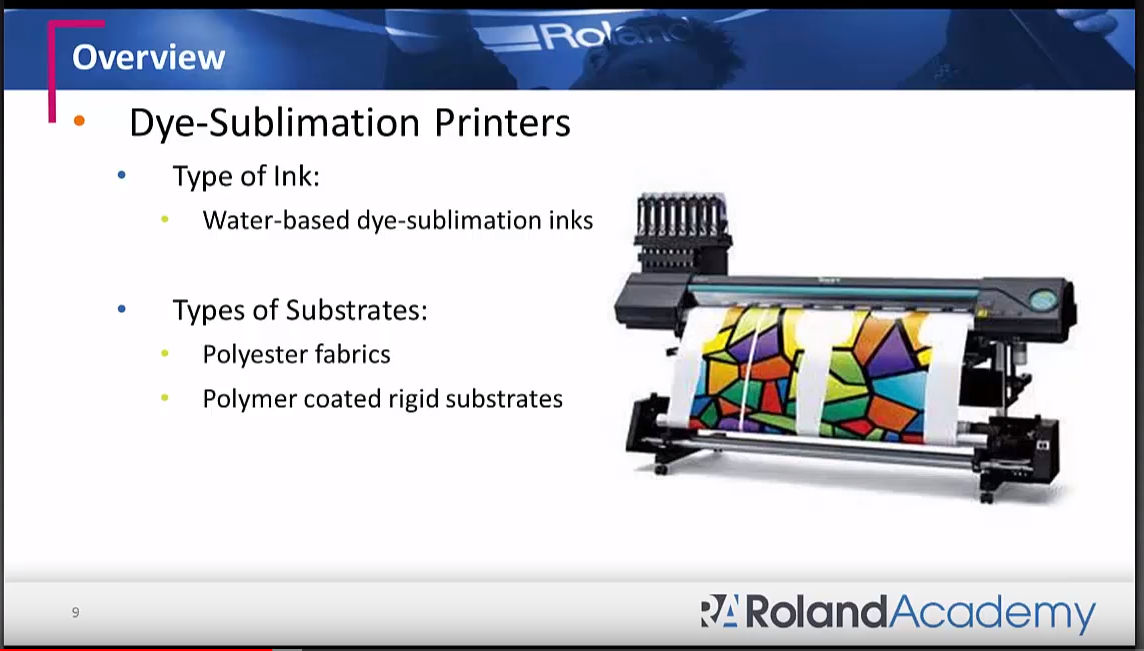
Impresión con Sublimación
Bueno, veamos cómo son las impresoras de sublimación y cómo se ven sus impresiones. Porque si usted no está familiarizado, se puede confundir. Primero, usted imprime en papel de transferencia, y el resultado puede ser opaco. Usted no verá colores brillantes y vivos. Así que este papel saldrá de la impresora con estas impresiones. Se va a ver bastante opaco, y está impreso de forma reflejada. La sublimación ocurre entonces en la estampadora: es ahí donde está la magia de los colores vivos. Para la sublimación, usted necesita calor, aproximadamente 204ºC, y presión, generalmente una mediana, para activar las tintas. En su papel de transferencia, usted tiene tinas sólidas. Están adheridas al papel. Usted las pone contra su tela de poliéster o sustrato rígido recubierto de polietileno, y aplica presión y calor a 204ºC. Es ahí cuando la tinta sólida se sublima en gas. Pasa por alto el estado líquido y se convierte directamente en gas, entrando a las fibras (de poliéster o recubrimiento de polímero) y se solidifica nuevamente. Ahora la tinta se unifica con la tela o sustrato rígido porque ahora no yace encima, sino que se ha vuelto parte de las fibras o recubrimiento. Con esto, usted verá vivacidad y resalte en los colores. Y, siendo las tintas ahora parte de las telas de poliéster, usted logra una excelente resistencia al lavado. Usted puede lavar año tras año y seguirá viéndose bien. Los colores seguirán resaltando. Lo ideal es que, al desechar su papel de transferencia, usted haya logrado que las tintas se hayan transferido entre un 80% a 90%. Esa tinta sólida se ha transferido desde el papel de transferencia hacia su tela. Es ahí donde usted notará la diferencia. Usted no verá el resalte inmediatamente luego de su impresión. Usted verá el resalte en la estampadora. Ahí está la mayor diferencia.
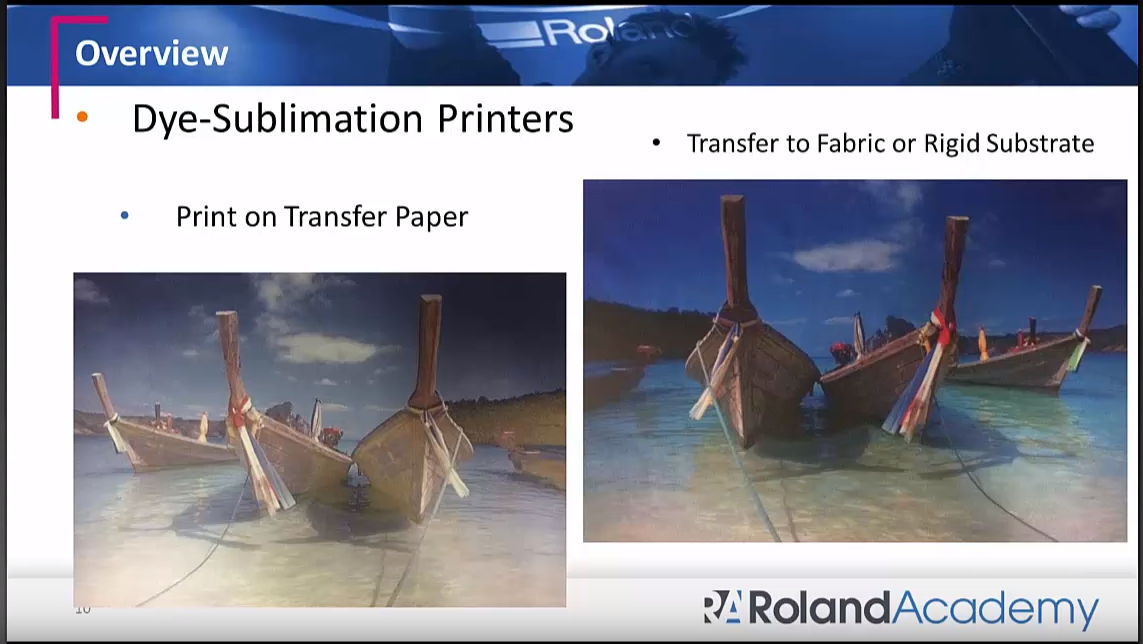
Tipos de Prensas
A partir de ahí, dependiendo de qué tipo de proyecto de sublimación usted realiza, determinaremos el tipo de prensa. Esta gran máquina roja a la izquierda es una máquina estampadora calandria. Es muy conveniente si uno va a producir letreros flexibles. Grandes telas, banderas, y cosas por el estilo. Es como una gran laminadora, pero alcanza los 204°C. Lo que usted hace entonces es imprimir en su papel de transferencia, y al terminar toma ese rollo de papel (para impresión rollo-a-rollo) y lo carga en la estampadora. Luego, toma su rollo de tela, lo carga a la estampadora, y ésta juntará los dos rollos. Pasará a través de estos rollos de calandria con calor (204°C) y presión, y entonces la transferencia comienza. Usted entonces obtendrá un buen rollo de tela al que se han transferido las imágenes. Esta es su máquina grande.
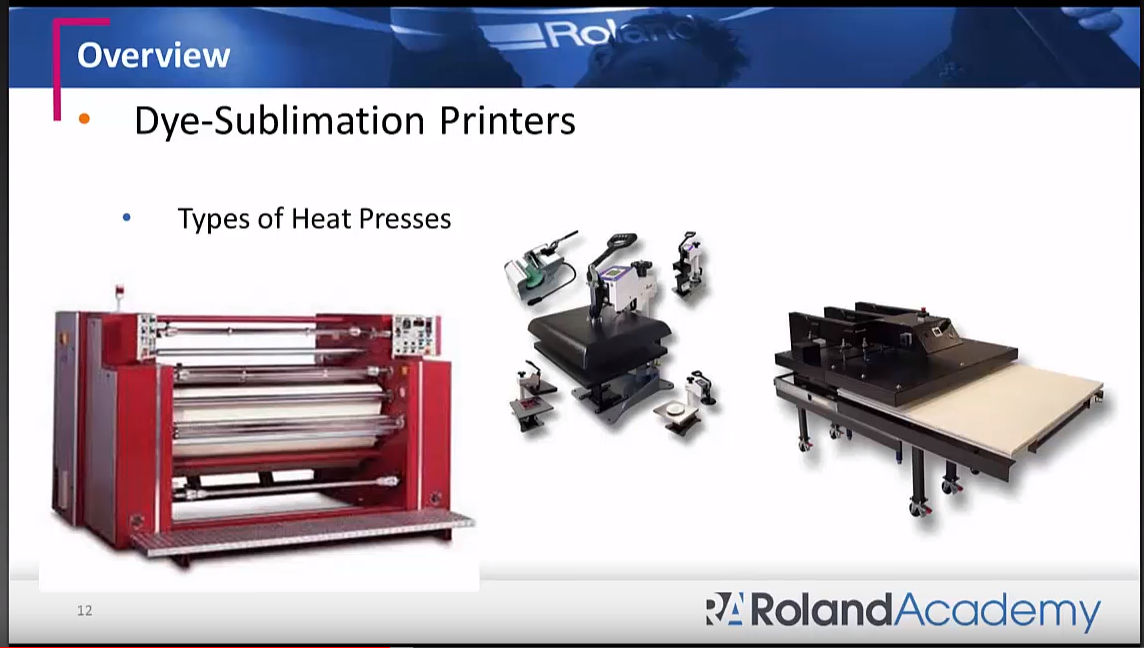
Para artículos pequeños especializados, esta estampadora mediana aquí, de cama plana, es ideal para camisetas y similares, alfombrillas para mouse o incluso paneles metálicos. También hay accesorios que usted puede conseguir para imprimir en tazas o platos, diferentes cosas con diversos grosores y formas curvas. Y también se puede trabajar con prensas al vacío o de membrana especializadas para imprimir sobre curvas poco usuales. Por tanto, es el calor y la presión lo que causa el proceso de sublimación.
Aquí tenemos esta gran estampadora de cama plana a la derecha. Si va a crear camisetas con gráficos completos o paneles múltiples, esta tiene una cama más grande con la cual puede hacer muchas cosas. Es una gran opción para hacer crecer su negocio. Digamos que usted quiere producir múltiples camisetas a la vez, o si desea crear gráficos que cubran por completo las camisetas, esta es ideal ya que usted tiene el espacio. Y si usted tiene esas cobijas de vellón o frazadas personalizadas, pues entrarán en la placa más grande de una forma más conveniente que si usara una pequeña.
Así que el tipo de prensa será determinado según lo que desee hacer. Puede ser una prensa similar, como la que obtendría si va a imprimir directamente a prenda, como la de cama plana, o puede ser una prensa rotativa si va a trabajar con letreros flexibles o incluso piezas de corte y confección. Para piezas de corte y confección, hay una mesa que funciona en conjunto con la prensa rotativa, la cual alimenta a la tabla. Usted solo coloca en la tabla sus pedazos de tela y papel de transferencia impresos, y esta los alimenta al rodillo. Por tanto usted no está limitado a un simple prensado rollo a rollo.
Impresoras DTG vs. Impresoras de Sublimación
Hagamos una rápida comparación de las impresoras DTG. Aquí algunos puntos clave rápidos. Las impresoras DTG son principalmente decoradoras de vestimentas. Usted puede imprimir en alfombrillas de mouse y otros productos. Por lo que he visto de algunos fabricantes, las impresoras están abiertas a otros artículos como bolsones, gorros y mangas (usando placas especiales incluidas), pero principalmente decoran vestimentas. Son buenas para 100% algodón, oscuro y claro. Una rápida nota: no todo el algodón es igual. El algodón hilado en anillo de más alta calidad con una trama más ajustada, como de 30 a 1, es ideal. Lo que hace es cerrar los poros, dándole una superficie más pareja sobre la cual imprimir, y no tendrá fibras sueltas colgando que puedan obstruir los cabezales de impresión. La selección de prendas es clave para lograr buenas impresiones con sus impresoras DTG. Usted puede trabajar en poliéster o telas sintéticas, pero recuerde: el pre-tratamiento es fundamental. Tiene que hacer un buen trabajo con esta, y ahí hay mucho por aprender, asegurándose de tener la cantidad adecuada de pre-tratamiento. Es necesario lograr los colores vibrantes y la resistencia al lavado. El pre-tratamiento definitivamente requiere talento.
Recuerde, la tinta blanca aún sigue siendo un problema. Las impresoras DTG son conocidas por tener problemas con los cabezales de impresión secándose o obstruyéndose con fibras. Al usar tinta blanca, las boquillas se obstruirán perjudicando sus impresiones. Asegúrese de hacer su mantenimiento diario y tener suficientes clientes como para imprimir continua y diariamente con tintas blancas. No es algo que usted deba dejar de lado: usted necesita clientela para colores oscuros, telas oscuras, o empezar con CMYK y no pasar primero con telas oscuras. Incluso si imprime directamente sobre la tela, recuerde que aún necesita curar las tintas sobre la tela con la prensa de calor. Estas son algunas de las cosas clave a tener en cuenta al considerar los pros y los contras de una impresora DTG o de sublimación.
Las impresoras de sublimación, como me he percatado, son muy versátiles y no limitadas a telas. Usted verá sublimación en vestimentas, muebles para el hogar, letreros flexibles, sustratos rígidos personalizados como aquellos paneles metálicos tan populares ahora y con bellas fotos. Esto definitivamente le puede dar un mayor beneficio al expandir su oferta. El requisito es que usted necesita tela de poliéster o cualquier tipo de sustrato duro recubierto de polímero. No solo eso, su sustrato también debe ser capaz de resistir 204°C y algo de presión por una cierta cantidad de tiempo. Para telas el tiempo puede ser entre 45 y 60 segundos, o un poco más dependiendo del tipo o grosor de tela. Para sustratos duros, puede ser entre un minuto, cinco minutos o más, también dependiendo del tipo de sustrato. Sus tazas pueden tardar cinco minutos. Sus paneles de metal pueden tomar 60 segundos. Sus mosaicos pueden tomar entre 5 y 6 minutos. Todo depende del producto.
Definitivamente no se necesita un pre-tratamiento adicional. Lo que algunos han tratado para reducir costos es simplemente agregar un pre-tratamiento de polímero al algodón o a otros ciertos productos. Pero hay también ahí una curva de aprendizaje ahí, porque si no aplica el pre-tratamiento delicadamente o en la cantidad correcta, podrá perjudicar su resultado final.
Hay muchos proveedores de productos en blanco para sublimación que venden camisetas de poliéster u otros productos con recubrimiento. Uno no tiene que preguntarse si puso suficientes capas o si lo hizo delicadamente.
Una vez más, el proceso de sublimación ocurre en la prensa de calor, así que cuando ve las impresiones en su papel de transferencia, no se desespere. Se verán opacas. Es cuando usted sublime en la prensa cuando los colores resaltarán. Evalúe sus colores luego de terminar con la prensa.
También, dependiendo de lo que haga, se puede requerir de un acabado adicional como costura o dobladillo. Quizás necesite invertir en una máquina de coser u otras cosas si desea hacer más que solo camisetas. Hay camisetas en blanco que usted puede decorar, sin embargo, si usted desea ser más creativo y desea cortar y coser diferentes piezas, definitivamente tendrá que invertir en una máquina de coser.
Ideas de aplicación de sublimación.
Permítame mostrarle unos cuantos ejemplos. Tengo algunos de impresión directa a prenda para darle una idea. Luego, tengo una variedad de diferentes ejemplos de sublimación.
Empezaré con un par de ejemplos de camisetas negras u oscuras para que puedan imprimir “directo a prenda”.
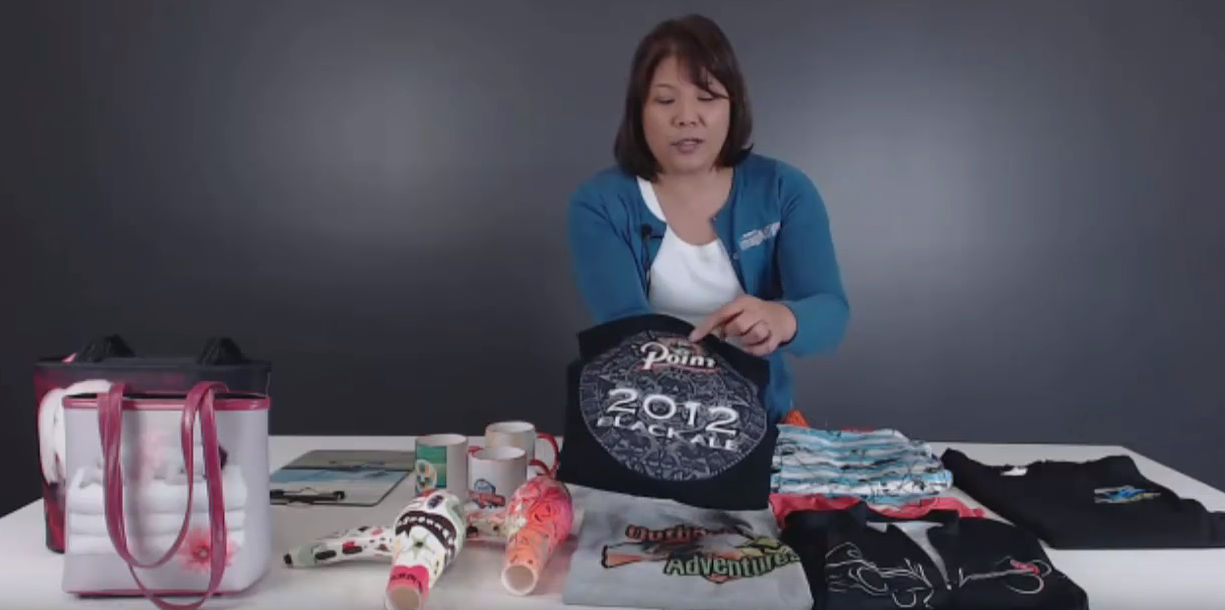
Para algo así usted tiene que aplicar la tinta blanca primero. Algo de la tinta blanca se mostrará. Esto será parte de sus gráficos. Usted diseñará qué se imprimirá y qué no en su diseño y en su software RIP. Este es un ejemplo de impresión sobre algodón oscuro, y la impresión “directo a prenda” (DTG) sería ideal para algo así.
Lo bueno, al imprimir, es que es mejor que la serigrafía y que uno puede crear fotos en gradientes y múltiples colores. Con la serigrafía, usted está limitado a solo unos cuantos colores antes de que todo se vuelva algo costoso. Pero en lo que respecta a costos, la serigrafía es mejor para producciones más prolongadas.
Para producciones de bajo volumen y camisetas personalizadas, usted puede contar con la impresión “directo a prenda” (DTG), y no solo para estas camisetas negras. Supuse que las camisetas negras serían buenos ejemplos para la impresión “directo a prenda” (DTG).
Sublimación y personalización de vestimentas
Ahora tenemos sublimación. Idealmente, usted empieza con una tela blanca de poliéster. Muchas de las chaquetas de ciclismo y de otro tipo son sublimadas. Si la voltea al revés, es blanca. Usted entonces diseña los colores. Usted tiene diferentes piezas que sublimará y luego coserá. Puede cortar y coser luego. Ya que tiene los bolsillos traseros aquí y es un diseño diferente. Las mangas tienen otro diseño también. Usted asigna su color negro. Así que no empiece con una superficie negra porque no existen las tintas de sublimación blancas. Usted empieza con blanco y asigna sus colores, y sus negros pueden aún ser muy vibrantes.
Aquí tenemos otra camiseta. Si la ve por dentro, es blanca. Esto indica que es un proceso sublimado. Esta también fue cortada y cosida, porque se ven costuras. Generalmente, si usted le pone gráficos a una camiseta y luego la estampa y luego le da vuelta y la vuelve a estampar... si lo hace con una camiseta en blanco, a veces en los bordes o costuras donde las tintas no han penetrado podrá ver algunas líneas blancas. En esta en particular no hay líneas blancas: trabajaron diferentes piezas y las cosieron juntas. Se ve muy bien.
Hay una empresa llamada Vapor Apparel. Crea muchos tipos de camisas y productos en blanco de sublimación, así como de colores. Esta está hecha de 100% poliéster hilado. Sé que no lo puede ver, pero se ve y siente como algodón, versus el poliéster de estas camisetas deportivas. Si sus gráficos son lo suficientemente marcados, usted puede sublimarlos en telas de colores claros. Como con esta, los colores del gráfico son definitivamente más vivos, así que cuando yo los sublimé en esta camiseta gris, no se vieron descolorados. Tiene un tacto suave y es muy durable, y la he lavado muchas veces y aún se ve muy bien.
Una vez más, tienen que ser 100% poliéster. Probablemente le salga bien con 80% poliéster. El asunto es que las tintas se subliman en gas y se adhieren a las fibras de poliéster. Lo que se adhiera en el algodón se desvanecerá, logrando un aspecto vintage.
Usted no está limitado a camisetas. Puede imprimir pantalones cortos. Esto es más que nada corte y confección. Este es un buen ejemplo de cuando fue prensado, cuando el papel impreso fue colocado aquí y el prensado ocurrió, la prenda no fue prensada correctamente así que hay arrugas. Es difícil de ver, pero sí hay arrugas. En realidad parece ser parte del diseño. Se ve bien en verdad. Aquí hay un par de arrugas en las que se prensó la imagen. Si usted la desdobla y la extiende, verá este gran espacio en el que las tintas no penetraron.
Al hacer un prensado completo en varias prendas sin coser, usted tiene que asegurarse de que su tela no tenga ninguna arruga ya que se mostrarán en los resultados. A menos que usted quiera ponerlas de moda. He visto casos en que se quería hacer esto como “innovación”. Usted puede cobrar más por eso.
Aquí va otra. Esta es una impresión, corte y confección. Una vez más, el interior es completamente blanco. Estas son solo ideas de lo que se puede lograr con la sublimación. Definitivamente usted necesita las prensas más grandes para hacerlas: las prensas de rodillos de calandria.
Diferentes Ideas de Aplicación de Sublimación
Cojines. Puede sublimar en ellos. En realidad, usted sublima sobre papel, o imprime sobre papel, sublima sobre la tela, y luego aplica un acabado.
Bolsas personalizadas. Las ve por todas partes.
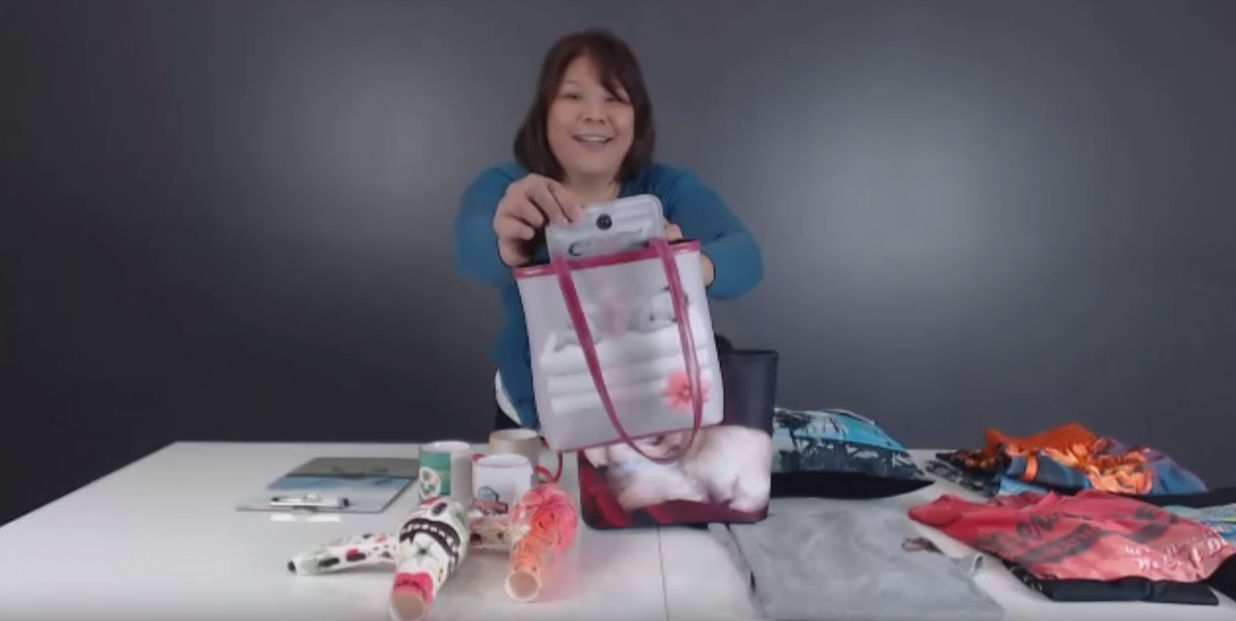
Excelentes regalos. Esta solapa aquí también está sublimada. Mucha versatilidad. Y como puede ver, diferentes formas.
Sublimación y sustratos duros
Veamos ahora sustratos duros. Este es un portapapeles sublimado. Al portapapeles se le agregó después la pieza de metal arriba. Y tazas, las personalizadas. Mucho de esto se logra con sublimación. Usted imprime una imagen reflejada sobre papel. Corta el papel. Lo envuelve alrededor de la taza y la coloca en una prensa para tazas. Así que usted ya no está limitado a una superficie plana. Usted puede también trabajar con superficies curvas.
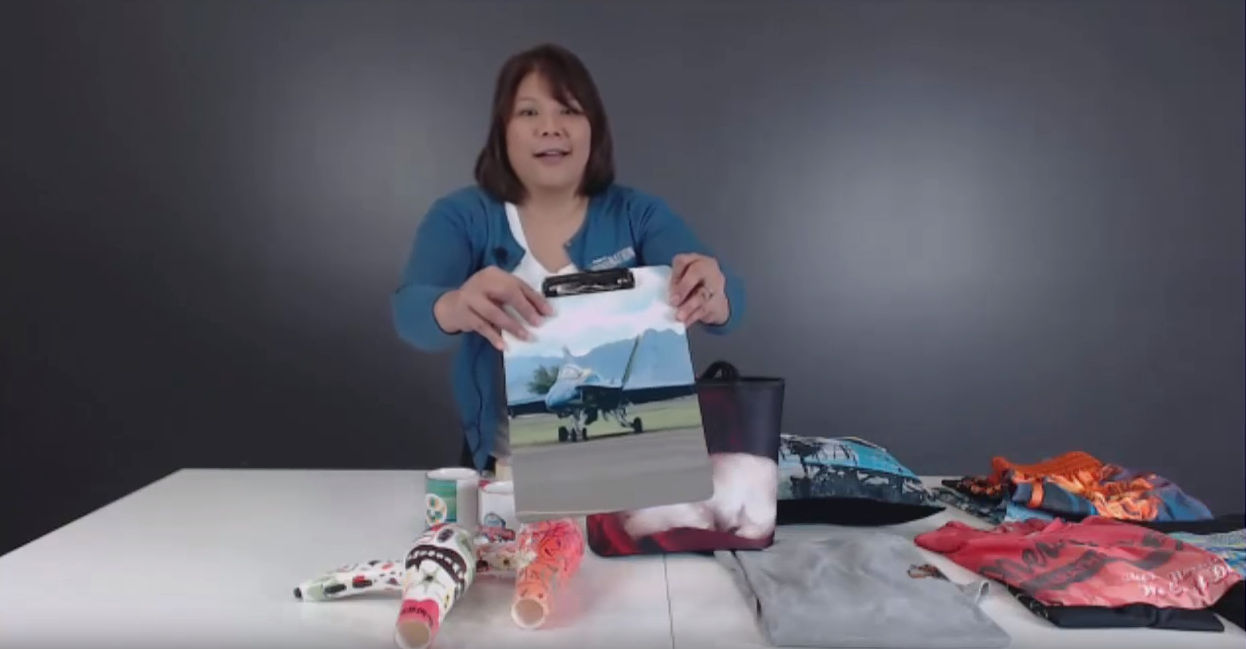
Nos enviaron estos para exhibirlos en nuestro Creative Center. Fueron sublimados. Obviamente, fueron hechos con una prensa al vacío curva especial. Qué interesante y bello todo lo que se puede lograr con la sublimación.
Acabemos con la presentación. Un par de diapositivas más y luego pasaremos a las preguntas. Algunos números de comparación respecto a costos de puesta en marcha. Veámoslos rápidamente.
Costos de Puesta en Marcha de Impresoras DTG
Impresoras DTG. Aquí algunos precios. En lo que respecta a impresoras, decentes y confiables... pues están entre US$ 15.000 y US$ 20.000. Luego hay que conseguir los accesorios y demás suministros de pre-tratamiento. Dependiendo de si usted va a comprar ese rociador o la gaveta... los costos varían. Así que estoy poniendo ejemplos de lo que he visto. Está también la prensa de calor, como la pequeña prensa de calor que mostré en las diapositivas, para empezar. Por tanto tenemos una inversión inicial de US$ 20.000 a US$ 29.000, esto sin incluir capacitación, tintas y todo lo demás.
Por lo que he visto en algunos blogs y foros en línea, ¿cuál es una buena expectativa del número de camisetas que podemos lograr por hora? Un blog que vi indicaba que usted puede producir entre 20 y 50 camisetas blancas por hora. No decía cuán grandes los gráficos eran, pero digamos que eran de 30 cm x 30 cm: 0,09 m2. Sin embargo, se pueden producir entre 8 a 15 camisetas oscuras por hora. La cantidad cae drásticamente al crear camisetas oscuras. Estas son algunas ideas que vienen de gente que hace esto. Usted ya tiene sus expectativas.
Costos de Puesta en Marcha para Sublimación
En lo que respecta a la sublimación, lo que hice fue redondear el costo de nuestra impresora a US$ 20.000. Tintas: tenemos 8 bolsas de 1 L que podemos poner aquí. Definitivamente sus contenedores están diseñados para una mayor producción. Las tintas cuestan US$ 9 por litro o bolsa. Usted necesita ocho de éstas. Y papel de transferencia. Nuestro papel de transferencia cuesta entre US$ 250 y US$ 260. Es de 162 cm x 135 m. La regla general aquí es empezar con un buen papel de transferencia.
Advertencia sobre el papel de transferencia: un buen papel de transferencia es aquel que permanece plano mientras usted imprime. No solo tiene que retener las tintas, sino evitar que se escurran. Especialmente si su diseño tiene muchas líneas y detalles finos. Un buen papel transferirá entre 80% a 90% de las tintas hacia la tela. Los buenos papeles cuestan entre US$ 1 y US$ 1,20 por metro cuadrado. No compre papeles que cuesten entre US$ 0,30 y US$ 0,50 ya que lo último que querrá usted hacer es tener que aplicar más tintas para obtener los colores y vivacidad que usted busca. Cuando usa estos papeles baratos, empieza a plegarse y golpear el cabezal de impresión, y los cabezales son muy caros. Y usted tiene que volver a hacer el trabajo una y otra vez. A la larga usted termina gastando más papel, más tintas y más tiempo al comprar papel a un precio entre US$ 0,30 y US$ 0,50 por metro cuadrado. Usted tiene que comprar algo confiable. Usted hace su trabajo una vez y no tiene que volver a hacerlo por un golpe al cabezal o algo parecido. Así que esa es mi advertencia sobre el papel de transferencia.
Las prensas de calor pueden costar tan barato como US$ 4.000, pero pongo un ejemplo de US$ 20.000: para una prensa rotativa de calandria, es un precio de entrada. Ahora bien, si usted desea adquirir lo mejor en prensas de calandria, considere gastar US$ 75.000. Esto si usa múltiples impresoras para sublimación y es todo lo que hace (su negocio principal, no un trabajo a medio tiempo). Las prensas de calor pueden variar, pero propongo una prensa rotativa de calandria para principiantes de aproximadamente US$ 20.000. Una inversión total de aproximadamente US$ 25.000 a US$ 41.000.
Aquí está la diferencia también: velocidades promedio de producción. Voy a mencionar algunas velocidades basadas en la impresora de sublimación RT-640. Si la ha configurado en cuatro colores, CMYK doble, y está haciendo cuatro pasadas en modo de producción 540 x 360 dpi, usted puede lograr aproximadamente 21 m2/hr. Para ocho colores, aproximadamente 10 m2/hr. Eso es bastantes impresiones. Si sus camisas tienen 0,1 m2 de gráficos, usted puede definitivamente lograr entre 20 y 50 camisetas. Incluso con el tiempo de prensado y todo lo demás, usted producirá una buena cantidad de camisetas.
Estas son algunas cosas a considerar según la tecnología “directo a prenda” (DTG) o sublimación.
Conclusiones
Si tienen temas que no abordé, me comunicaré con ustedes directamente. Esto concluye nuestro seminario de hoy sobre DTG vs. sublimación. Aprecio su participación y espero haberles dado respuestas e información para que tomen buenas decisiones. Sea la que sea, sublimación o DTG, lo importante es tener la clientela antes de invertir. Porque como ustedes vieron, hay enormes gastos iniciales. Asegúrese de tener la clientela adecuada porque usted no querrá gastar miles de dólares en una máquina solo para que termine acumulando polvo. Contacte a un mayorista y cree una carpeta de clientes. Una vez que obtenga esa clientela, invierta. Aprenda todo lo que pueda. Lea blogs, vaya a convenciones, y aprenda y vea lo que está disponible y qué le conviene mejor. Hay definitivamente muchas opciones. La tecnología ha evolucionado, pero aún hay problemas que tienen que solucionarse. Por ejemplo boquillas obstruyéndose con tinta blanca e incluso tintas de pigmentación no respondiendo bien para ciertos tipos de telas. Vea qué es lo que se ofrece.
Tenemos videos y documentación de apoyo en nuestro canal de YouTube que se indica aquí. Este seminario en línea está siendo grabado para nuestros archivos, junto con otros no solo sobre sublimación sino sobre una gran variedad de temas. Puede ser usado como un recurso. Visiten otros sitios Web y no duden buscar en los archivos. De este modo, si tiene preguntas, espero que algunos de estos seminarios en línea educativos puedan responder algunas de estas preguntas. Quiero agradecerles por su tiempo, y desearles un buen día.
